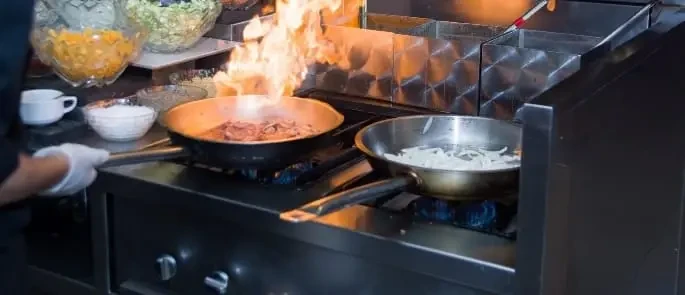Kitchen safety is paramount. Understanding the main hazards can significantly reduce risks. Physical injuries from sharp tools and hot surfaces are common but preventable with proper handling and Awareness. Chemical exposure from cleaning products or pesticides requires careful storage and usage to keep everyone safe. Biological threats, like bacteria lurking in food, highlight the importance of good hygiene practices. Cooking accidents can lead to fire hazards if not managed correctly; staying attentive while cooking is critical.
Physical hazards

The kitchen is a bustling hub of activity, but it can also be a playground for physical hazards. Sharp knives and utensils are essential tools, yet they pose a significant risk if mishandled. A momentary slip can lead to deep cuts that require medical attention. Burns are another common concern in culinary spaces. Hot surfaces, boiling liquids, and stovetops demand respect. It only takes an instant to get burned while reaching for that pot or pan. Even seemingly innocuous items like glass dishes can become dangerous when mishandled. Broken shards can cause severe injuries if stepped on or touched without care. Awareness is the first step toward safety in the kitchen. Keeping your space organized helps minimize these risks significantly.
Cuts and burns from sharp objects and hot surfaces
The kitchen is a bustling place with tools designed to make cooking easier. These same tools can pose serious dangers. Sharp knives and utensils are essential for food preparation but require caution. A moment of distraction can lead to painful cuts. Focusing on the task at hand is critical when handling sharp objects. Use cutting boards and proper techniques to minimize risks. Hot surfaces add another layer of danger. Ovens, stovetops, and even pans retain heat long after use. Always use oven mitts or pot holders when touching anything that could burn you. Accidents happen quickly in the kitchen environment. Staying aware of your surroundings will help prevent injuries from cutting instruments and hot surfaces. A little mindfulness goes a long way in ensuring safety while you cook up delicious meals!
Chemical hazards

The kitchen is often a hub of activity but can also harbor unseen dangers. Chemical hazards are among the most overlooked risks we face while cooking and cleaning. Common culprits include cleaning products. Many contain harsh chemicals that can cause skin irritation or respiratory issues if inhaled. Reading labels carefully and using these substances in well-ventilated areas is essential. Pesticides are another hidden threat. They might linger on fruits and vegetables, posing health risks if not washed thoroughly before consumption. Avoiding chemical exposure starts with proper food handling practices. Even everyday items like dish soap can be dangerous if ingested or misused around food prep areas. Keeping these products stored safely away from cooking zones helps minimize accidents.
Cleaning products, pesticides, and other toxic substances
Cleaning products play a crucial role in maintaining kitchen hygiene. However, many contain harsh chemicals that pose significant risks if misused. Pesticides are another concern. Residues on fruits and vegetables may linger, leading to potential health issues when consumed. Washing produce thoroughly is essential but might not eliminate all harmful substances. Toxic substances can also come from improperly stored items. Mixing different cleaners can create dangerous fumes, so it’s vital to read labels diligently. It is important to keep these products out of reach of children and pets. Ensure proper ventilation while using them to reduce inhalation risks. Always follow usage instructions carefully for your safety. Awareness is the first step in preventing accidents related to chemical hazards in the kitchen.
Biological hazards

Biological hazards in the kitchen can pose serious health risks. These often originate from bacteria, viruses, and parasites that contaminate food. Raw meats are prime culprits for bacterial growth. Salmonella and E.coli can thrive if not appropriately handled. Cross-contamination occurs when juices from raw foods are mixed with ready-to-eat items. Fruits and vegetables aren’t exempt, either. They can carry harmful pathogens if washed inadequately or grown in contaminated soil. Improper storage of leftovers creates a breeding ground for germs as well. Foods left out too long encourage rapid bacterial multiplication. Cooking at the right temperature is crucial to kill these unwelcome guests, and using a food thermometer helps ensure safety while preparing meals.
Food-borne bacteria, viruses, and parasites
The kitchen is a breeding ground for unwanted microorganisms. Bacteria, viruses, and parasites can easily slip into our meals if we’re not careful. Raw meats are particularly notorious. They often carry harmful bacteria like Salmonella and E. coli. If they come in contact with other foods, cross-contamination can occur. It’s also important to eat fruits and vegetables. They can harbor pathogens from soil or water contamination. Washing them thoroughly is crucial to reduce risks. Viruses such as Norovirus are also common culprits of foodborne illnesses. These microscopic invaders spread quickly through improperly handled food or surfaces.
Fire hazards
Regarding cooking, fire hazards can turn a delightful meal into a disaster in seconds. A moment of distraction near hot oil or an open flame can lead to severe accidents. Cooking appliances are often the main offenders. Faulty wiring, malfunctioning burners, and overloaded circuits create potential dangers that shouldn’t be ignored. Regular maintenance is crucial. Grease buildup on stovetops and ovens also poses a significant risk. It’s essential to keep surfaces clean and free from flammable materials. Even kitchen towels or paper products can ignite if left too close to heat sources. Always watch your surroundings while you cook; vigilance goes a long way in preventing fires.
From cooking accidents or faulty appliances
Fire hazards can be found in the kitchen, which is often the center of the home. Cooking accidents are surprisingly common. A momentary lapse in attention while frying or boiling can lead to flames that spread quickly. Faulty appliances add another layer of risk. An old toaster may spark when plugged in, and a malfunctioning stove could ignite nearby materials. Regularly inspecting these devices is crucial for safety. Always keep flammable items away from heat sources. Oven mitts, dish towels, and paper are easy targets for accidental fires. It’s wise to have a functioning smoke detector installed nearby. This small device can provide an early warning if things get out of hand.
Tips for preventing kitchen hazards
Keeping your kitchen safe requires vigilance and a few simple practices. Keep sharp knives stored safely, preferably in a knife block or magnetic strip. This minimizes the risk of accidental cuts. Wear appropriate clothing while cooking. Aprons can protect against spills, while closed-toe shoes guard your feet from falling objects. Regularly check your appliances for wear and tear. Faulty toasters or frayed cords are fire hazards waiting to happen. Proper food storage is crucial. Ensure leftovers are refrigerated promptly to combat bacterial growth. When using cleaning products, read labels carefully and store them out of reach of children. Opt for natural alternatives when possible; they reduce chemical exposure. Maintain a clutter-free workspace to prevent accidents as you move about the kitchen freely, allowing you to focus on what matters: cooking delicious meals!




